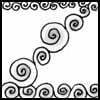 Whew, thank goodness we made it to Monday unscathed! Welcome back my friends, lovely to see you …
Whew, thank goodness we made it to Monday unscathed! Welcome back my friends, lovely to see you …
After a stressful weekend while we monitored what fortunately turned out to be only a Tropical Storm, I needed a really, really SIMPLE tangle.
And Belgian tangler Tina Raymaekers came to my rescue with her Switching tangle. Easy, easy, easy. And so surprisingly versatile. (And somewhat symbolic of the weekend!)
Previously Tina shared her Diam’n Feel with us.
Now I know you’ll say there are similar spiral tangles on the site, and I would not disagree with you. But with the exception of the Zentangle®-original Snail that doesn’t “switch” and the grid-based Tortuca, other similar tangles are more embellished designs. CZT Suzanne McNeill’s Eddy is possibly closest in similarity although her approach to construction is completely different.
The straightforward Switching deserves some exploration.
Tina writes,
I’ve been doubting to use this one, ’cause I’ve been drawing this since my secondary school years … every binder has it mentioned somewhere.
It’s a quite easy one, the only tricky part is that the drawing switches from where you start drawing it: on, under, on, under, … That’s where the name comes from.
It can be a border, but due to the curves you can use it as a string as well, or make a figure out of it. It can even be used as a grid.
In addition to Tina’s suggestions for Switching, you can explore variations a bunch of ways. They can be tangled in parallel lines, in condensed or open rhythmic arrangements, and with a change in scale/proportion, which I played with a bit in my humble example.
But wait! There’s more! To add more fun to the Switching mix, experiment further with square/fret versions (à la Emingle or Box Spirals), or triangle versions like Triral, or tear-drop shaped like Ansu, or even wonky ones like Elirob. It has more fun and complex possibilities than its simple form initially conveys.
Spirals have been around for millennia. They appear in art and architecture and of course in nature, on every continent in the world as detailed under the “As a symbol” heading on the Wikipedia entry:
A spiral like form has been found in Mezine, Ukraine, as part of a decorative object dated to 10,000 BC.
The spiral and triple spiral motif is a Neolithic symbol in Europe (Megalithic Temples of Malta).
The Celtic symbol the triple spiral is in fact a pre-Celtic symbol. It is carved into the rock of a stone lozenge near the main entrance of the prehistoric Newgrange monument in County Meath, Ireland. Newgrange was built around 3200 BCE predating the Celts and the triple spirals were carved at least 2,500 years before the Celts reached Ireland but has long since been incorporated into Celtic culture.
The triskelion symbol, consisting of three interlocked spirals or three bent human legs, appears in many early cultures, including Mycenaean vessels, on coinage in Lycia, on staters of Pamphylia (at Aspendos, 370–333 BC) and Pisidia, as well as on the heraldic emblem on warriors’ shields depicted on Greek pottery.
Spirals can be found throughout pre-Columbian art in Latin and Central America. …
Spiral shapes, including the swastika, triskele, etc., have often been interpreted as solar symbols. Roof tiles dating back to the Tang Dynasty with this symbol have been found west of the ancient city of Chang’an (modern-day Xi’an).
… The spiral is also found in structures as small as the double helix of DNA and as large as a galaxy.
There’s a variety of basic spiral types, I’ve included a sampling below. Learning more about spirals is truly fascinating, so be sure to begin with a read on Wikipedia.
Tina illustrates the step-by-step instructions for drawing Switching below, “In my drawing I just kept it as a straight string and added some shade in the middle of the curl.” Enjoy exploring the simplicity — and potential complexity — of this fun symbolic shape!
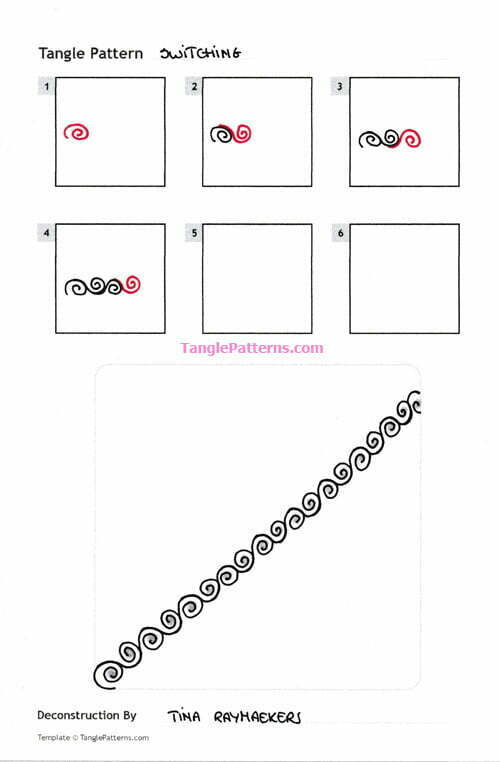
Image copyright the artist and used with permission, ALL RIGHTS RESERVED. These images are for your personal offline reference only. Please feel free to refer to the images to recreate this tangle in your personal Zentangles and ZIAs. However the artist and TanglePatterns.com reserve all rights to the images and they must not be publicly pinned, altered, reproduced or republished. Thank you for respecting these rights. “We must all face the choice between what is right and what is easy.” ~ Albus Dumbledore
As you enjoy any of the tangles on the site, please leave a comment of thanks and encouragement to show the artists you appreciate them for sharing their creativity to inspire yours. Your thanks helps motivate them to continue to share! And please share a link to your favorite tangles on social media. Thanks!
Check out the tag tinar for more of Tina’s tangles on TanglePatterns.com.
Related Links
- Looking for tangles by Artist or Type? For details visit the ABOUT > HOW TO FIND TANGLES BY ARTIST OR TYPE page on the top menu bar of any page on the site.
- What is a Zentangle? — if you are new to the Zentangle Method, start here for the fundamentals.
- Zentangle terminology — a glossary of terms used in this art form.
- How to use the site — an excellent free video tutorial showing how to use the site as well as pointing out lots of useful features you might have missed.
- Linda's List of Zentangle-Original Patterns — here is the complete list of original tangles (aka "official tangles") created and introduced by founders Rick Roberts and Maria Thomas, including those not published online. If you are new to the Zentangle Method I highly recommend learning a few of the published Zentangle classics first.
- "A Zentangle has no up or down and is not a picture of something, so you have no worries about whether you can draw a hand, or a duck. You always succeed in creating a Zentangle." Patterns that are drawings of a recognizable naturalistic or actual object, figure, or scene, are not tangles. A pattern is not always a tangle — here's what makes a tangle. TIP: tangles never start with pencil planning.
- Un motif n’est pas toujours un tangle — Qu’est-ce qu’un tangle ?
- Un diseño no es siempre un tangle — ¿Qué es un tangle?
- How to submit your pattern deconstruction to TanglePatterns
- For lots of great FREE tutorials on TanglePatterns, click on the TUTORIALS link in the pink alphabetic menu bar below the tangle images at the top of any page.
- Strings! Have we got STRINGS! Click on the STRINGS link in the pink alphabetic menu bar below the tangle images at the top of any page for 250 different (free) Zentangle-starters. More than enough for any lifetime!
- Never miss a tangle! FREE eMAIL NEWSLETTER - visit the Here's how to SUBSCRIBE button (top of left sidebar on any page) and sign up to get notices delivered free to your inbox.
- If you have questions about the TanglePatterns.com TANGLE GUIDE, visit the BOOK REVIEWS tab on the top menu bar of any page on the site for COMPLETE details!
|
.oOo. |
|
Enhance your Zentangle experience while supporting TanglePatterns: |
|
CURRENT EDITION! TanglePatterns.com TANGLE GUIDE, 2025 Edition |
|
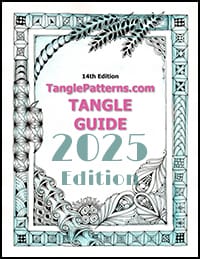 |
The 14th Edition of the TanglePatterns.com TANGLE GUIDE is an instant-download 117-page interactive digital eBook/PDF containing over 2,000 tangles on the site from May 2010 through December 31, 2024. It's a great resource and a must-have digital tool for using the site. Visit the STORE > E-BOOKS page and help keep TanglePatterns.com going by getting your copy now! |
|
"Linda, Thank you! I was relying on too few and getting stuck after 3 years of daily working with Zentangle. This has inspired me to ‘begin again’ with renewed excitement." ~ Barbara R. |
|
| See the BOOK REVIEWS page for more details on its features and view a sample page. Note: this is a digital product you download immediately when you place your order, nothing will be physically mailed to you. | |
| If you're new to Zentangle® and tangling, my TanglePatterns.com BEGINNER'S GUIDE TO ZENTANGLE is just what you need to get started. Also available en Français and en Español. | |
|
|
|
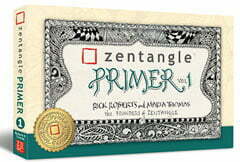 |
This is the only Zentangle book you'll ever need: the fabulous Zentangle PRIMER Vol 1. It's your CZT-in-a-book by the founders of Zentangle®. Visit the STORE tab on the top menu bar or click on the image. For more about the content and to read the rave reviews, visit the BOOK REVIEWS tab. |
| Now available in KINDLE format for $9.99. Spanish Edition here. Japanese Edition here. | |
| "Absolutely the best Zentangle Book yet! As an accomplished artist I used to think I did not need instruction on this art form. How wrong I was! My tangling improved by leaps and bounds after reading this book. If you think you have Zentangle down then you need this book more than ever!" ~ Kris H | |
|
|
|
|
.oOo. |
|






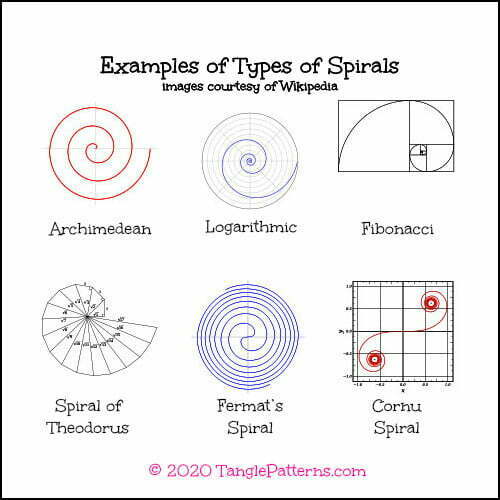


That’s a fun one and SO simple! Thanks, Linda, for mentioning all those variations as well as the “named” examples. I am looking forward to a spiral of playtime! 🙂
How is this not a tangleation of Printemps?
I’ve been really enjoying seeing all the ways Switching can be used in my tiles! I love it as a border (I’m always looking for borders) as the possibilities are endless 🙂 What a fun and lovely tangle!
And Linda, thank you for the interesting lessons that go along with the tangle step outs and explanations. I love reading the socio-cultural history that you provide with each new post!
love this design-great filler-many thanks